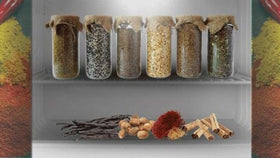What is Sumac?
Ingredient Profile: Getting to Know Sumac
It’s barbecue season, and if you’re the prep cook in your household, you may have spotted sumac on the ingredient list of some of those marinade or rub recipes you've been meaning to try. While it’s not quite a common staple in most U.S. kitchens, this bold, ruby-hued spice has been prized in Mediterranean and Middle Eastern cuisine for ages and is quickly gaining popularity worldwide.
This may be especially true for warm-weather recipes intended to land on the grill. Sumac adds a vibrant, lemony tang that’s perfect for waking up those summertime dishes that can sometimes feel a bit heavy on the palate. If you haven’t yet added it to your spice cabinet, this might be the summer to give it a try.
Before you fully commit to adding this ingredient to your pantry, though, let’s make sure you have a firm understanding of what sumac is, what it tastes like, and how it can be used to uplift your dishes. Bonus: We’ll provide tips to ensure you’re only sourcing a quality product.
What Is Sumac?
Culinary sumac is a tangy, reddish-purple spice made from dried and ground berries of a shrub scientifically known as Rhus coriaria. Though Rhus coriaria is native to the Mediterranean region, the genus it belongs to spans the globe, and all members are found within the Anacardiaceae family, which includes more recognizable produce items such as cashews and mangoes.
It should be noted that there are many members of the Rhus genus, and not all are edible. Many are strictly ornamental and others can cause severe allergic reactions—most famoursly, poison ivy, poison oak, and poison sumac.
What Does Sumac Taste Like?
Sumac is one of those flavors you can’t fully grasp without tasting it yourself. Since we can’t magically transport you into a flavor experience, I’ll do my best to describe it here.
Imagine a perfectly ripe lemon that has been dried in just the faintest amount of smoke, its brightness mellowed but still vibrant. Zest that lemon and stir in a bit of fermented sun-dried tomato and a trace of sweet paprika. Sumac is kind of like that. Let tit rest on your tongue and you’ll notice a similar profile to the one we just describe. The flavors will arrive in waves. It starts with a tart, citrusy brightness, then reveals a savory depth, and a muted umami tone lingers.
What is Sumac Used For?
The flavor of sumac brings a subtle tartness that uplifts dishes without overshadowing other flavors, offering acidity without adding liquid like lemon juice or vinegar. This makes it a great ingredient for spice rubs and fattier proteins whose final destination before consumption is the grill.
Sumac is also a fantastic addition to salad dressings, marinades, and starchy dishes like potatoes, rice, and corn.
Some of our favorite out-of-the-ordinary uses for ground sumac include sprinkling it on popcorn, seasoning a savory bread pudding with asparagus and mushrooms, blending it with mayonnaise and spreading it on sandwiches, sprinkling it on top of roasted cauliflower, and using it as a rub for dry-smoking fish.
More commonly, sumac is known as a key ingredient in Mediterranean, Turkish, Persian, and North African cooking. Some of the most recognizable uses include its place in the za’atar spice blend, the vinaigrette that lends its unmistakable flavor to the popular Middle Eastern vegetable and bread salad called fattoush, and the Palestinian chicken and caramelized onion dish called musakhan. It is also commonly incorporated into hummus, kofta, and—more unexpectedly—paired with fruit.
Are There Suitable Substitutions For Sumac?
Sumac has a very unique flavor profile with many layers, so you will be hard pressed to find a single ingredient that will serve as a suitable substitution. That said, there are ingredients that can be swapped in a pinch. Before we dive into what those are, it’s important to consider the role sumac is intended to play in the recipe at hand before determining the substitution.
If you’re looking to replicate the bright, tangy flavor of sumac in a dry rub, try some lemon zest, or for a vibrant marinade, a splash of lemon juice or apple cider vinegar should do the trick. Finding a substitution that will mimic the layers of flavor sumac supplies is a bit tricker. Amchur, a dried green mango powder that lends a similar balance of acidity and earthiness, is a suitable substitution but tends to be even harder to come by. Another option would be to make your own concoction of more common ingredients that could bring in the different tones and elements you want pronounced in your dish. Try combining lemon zest with a bit of sweet paprika and ground coriander for a homemade mix that highlights many of the same notes.
Keep in mind that while these substitiutions can approximate sumac's role in a recipe, they won’t fully replicate its layered flavor. If you’re using sumac for its signature zing in dishes like fattoush or sprinkled on grilled meats or vegetables, it's worth seeking out the real thing whenever possible.
Where Can I Buy Culinary Sumac?
Sumac powder and whole dried sumac berries aren’t typically found in the spice section of your average grocery store. However, as it continues to gain popularity, you may spot it in the international cuisine aisle. More reliably, you’ll find it at Middle Eastern markets, specialty spice shops, or online (shameless plug: like in our ethically sourced spice shop).
Wherever you choose to source your sumac, we have a few tips to ensure you're getting high-quality spice:
-
Check the ingredient list. There should only be one ingredient: dried sumac. If you see salt, citric acid, or other additives, skip it.
-
Look at the color. Good-quality sumac should be a deep red to dark burgundy, with occasional flecks of lighter red, yellow, orange, or brown. If it’s mostly brown, orange, or pale red, that’s a sign of poor quality. Put it back on the shelf.
-
Assess the appearance. High-quality sumac looks vibrant and may even have a slight oily sheen. If it appears dull or dusty, it’s not the one.
-
Smell it, if you can. A strong, citrusy aroma should hit your nose. If it smells flat or faint, it’s likely past its prime.
-
Do your homework. If you’re buying from a brand or online vendor, look into their sourcing practices and customer reviews. If their transparency or reputation raises red flags, it may be worth choosing a more trusted source.










Slofoodgroup
Auteur